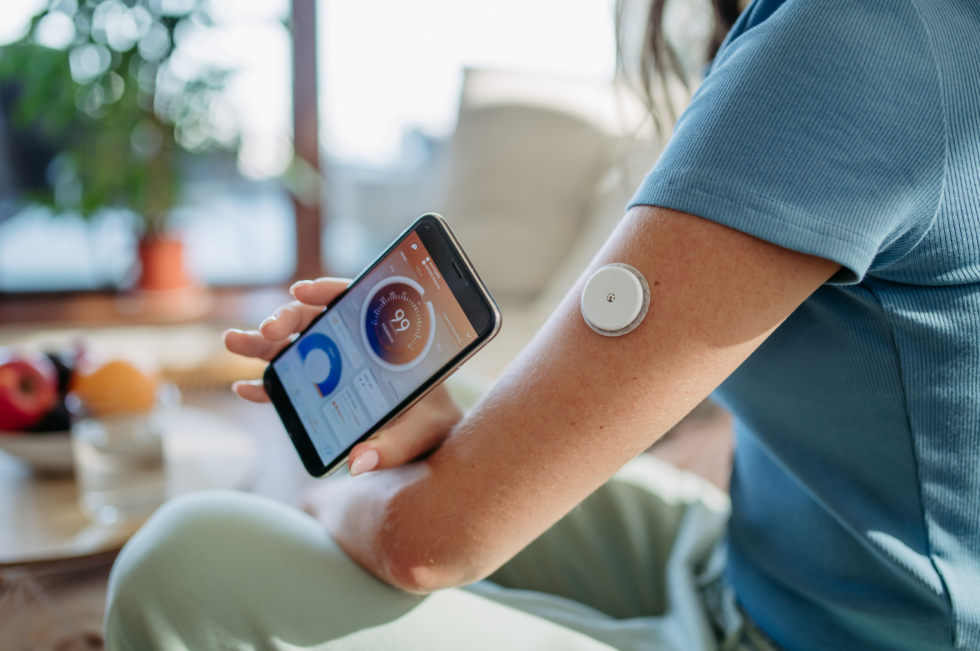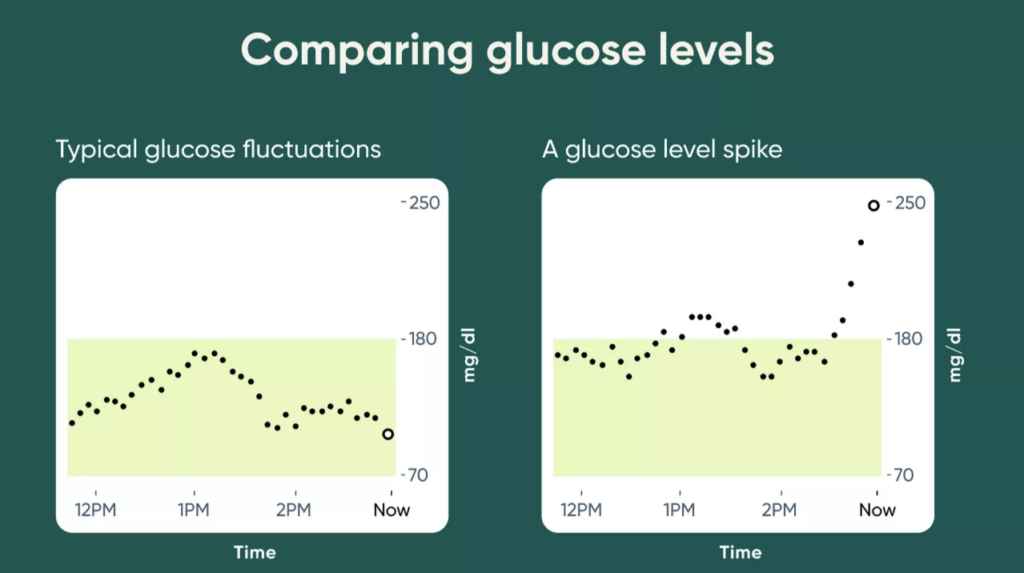
Everything You Need to Know About Continuous Glucose Monitors (CGMs)
There are so many amazing at-home tools available to help you understand your health, and one of my absolute favorites is a Continuous Glucose Monitor (CGM). Recently, I had the opportunity to discuss CGMs on Twin Cities Live, and I wanted to dive deeper into why these devices can be life-changing, especially if you’re working on balancing your blood sugar.
What is a Continuous Glucose Monitor (CGM)?
A Continuous Glucose Monitor (CGM) is a small sensor you wear on your body (typically your arm) that measures your blood glucose levels down to the minute. The sensor typically lasts about 2 weeks and connects to an app on your phone, giving you real-time data about how your blood sugar responds to your meals, exercise, sleep, stress, and more.
If you’ve ever wondered why you feel a post-meal energy crash, why you wake up groggy after a late-night snack, or what you can do to better manage your blood sugar levels, a CGM can help give you those answers. This tool can provide you with an understanding of your blood sugar levels, empowering you to make food and lifestyle changes that keep your blood sugar stable, as well as your energy levels.
Benefits of Using a CGM
The insights a CGM provides can be powerful, especially when it comes to reaching your health goals. Here are a few of the biggest benefits of using a CGM:
Real-Time Feedback
Unlike a hemoglobin A1c blood test that gives you an average of your blood sugar over 3 months, or a fasting blood sugar test that tells you your blood sugar level at that single point in time, a CGM will tell you your blood glucose level at any time throughout the day. Instead of guessing how your food choices impact your blood sugar, you get clear, immediate data. For example, you can see if your go-to breakfast is causing a massive blood sugar spike or if your favorite lunch keeps your blood sugar stable until dinner.
Improved Energy and Mood
Your blood sugar plays a massive role in how you feel throughout the day. When blood sugar is stable, you’ll notice fewer energy crashes, mood swings, and sugar cravings. CGMs help you identify which meals or habits are causing dramatic fluctuations, so you can make adjustments to keep your energy and mood stable all day long.
Better Metabolism and Weight Management
Blood sugar regulation is directly tied to metabolism and weight. Frequent blood sugar spikes, followed by crashes, can lead to increased hunger and weight gain. By using a CGM, you can identify and reduce those spikes, which can help you lose weight, improve your metabolic health, and reduce stress on your body.
Personalization
Food impacts everyone differently, and what works for one person may not work for another. A CGM allows you to tailor your diet and lifestyle specifically to your body. This will allow you to make targeted interventions, helping you reach your goals quicker because you have the data to know what is working almost immediately.
Understanding Your CGM Data
Target Ranges
For most people, a healthy blood sugar range is:
- Fasting blood sugar: 70-90 mg/dL
- Post-meal (1-2 hours after eating): ideally staying under 140 mg/dL
- Overall daily range: Consistently staying between 70-120 mg/dL is optimal for stable energy and metabolism
Tips for Interpreting Data
- Establish a baseline: When you first use a CGM, it’s helpful to establish some baseline data. Evaluate how your current eating and lifestyle habits are impacting your blood glucose levels.
- Watch for spikes: A rapid increase in blood sugar (above 140 mg/dL) followed by a crash can indicate that a meal or snack may not have had the right balance of carbohydrates, protein, and fat.
- Aim for stability: A more gradual rise and fall in blood sugar (staying within 30 points of your baseline) suggests that a meal is balanced with enough protein, fiber, and fats.
- Identify patterns: What are your typical glucose patterns? For example, if you consistently see high blood sugar levels in the evening, it may be because of carb-heavy dinners, or late-night snacking.
- Impact of Exercise: Muscle uses blood sugar for energy so don’t be surprised if you see a temporary blood sugar drop below 70 mg/dL with exercise.
- Impact of alcohol: When we consume alcohol, our liver has to work to detoxify it, which can lead to low blood sugar levels. Additionally, consuming alcohol on an empty stomach can cause dips in blood sugar.
- Impact of sleep and stress: Do you notice a blood sugar spike before an important meeting at work, when you’re rushing your kids out the door in the morning, or after getting a poor night’s sleep? That’s because stress and not enough sleep can raise blood sugar levels.
Data Example
Below are two graphs showing stable and unstable blood sugar levels.
The graph on the left shows a smooth, rolling hill with a steady range – what you may see after consuming a balanced meal. While the graph on the right shows a large spike, indicating that a meal or snack was lacking the proper macro balance of protein, fat, or fiber-rich carbs.

Optimizing Blood Sugar Levels
If you want to keep your blood sugar stable and optimize your metabolism, here are some simple strategies:
- Prioritize protein: Eating protein with each meal and snack helps to slow the digestion and absorption of glucose, preventing spikes and leaving you satisfied. Not sure how to get more protein? Try out my FUELED Community for high-protein meal plans sent right to your inbox every Friday.
- Be mindful of carbs: Focus on complex carbs that take more time to digest, and prevent a huge blood sugar spike. Examples include vegetables, fruit, beans, and whole grains like brown rice or quinoa.
- Move after meals: Research has found as little as two minutes of movement after meals can help lower glucose spikes. Try going for a walk after meals, use a stand up desk, or do some yoga stretches.
- Manage stress and sleep: Chronic stress and poor sleep can lead to higher blood sugar levels. Prioritize quality sleep, and support your body with daily stress.
Popular CGM Brands
Until recently, CGMs were only available to those with a diagnosis of diabetes and with a prescription from a doctor. Now, there are over-the-counter options that anyone can purchase at an affordable rate. Here are three options:
Dexcom Stelo
Dexcom recently launched the Stelo, and over-the-counter CGM designed for adults who are not receiving insulin therapy, no prescription needed! The sensor connects to an app on your phone and continuously tracks your blood sugar levels. You can purchase two sensors ( a 30-day supply) for $99 or subscribe for monthly deliveries at $89 per month.
Abbott’s Lingo
Another great option is Lingo by Abbott. This is also an over-the-counter CGM (no prescription needed) designed for health-conscious individuals who want to optimize their blood sugar levels. Pricing options include $49 for two weeks or $89 for four weeks. The only downside is it’s only compatible with iPhone users.
Nutrisense
Nutrisense is a CGM brand providing real-time glucose tracking but also includes access to registered dietitians who can interpret your data and offer personalized nutrition guidance. This is great for someone looking to combine technology with personalized coaching; however, it does come at a higher cost of $225 per month for a 12-month subscription.
CGMs for Those With Diabetes
Freestyle Libre by Abbott
The Freestyle Libre by Abbott is a prescription-only CGM for those with diabetes. If you’re interested, speak with your doctor to see if you are a candidate. You may be able to get this CGM free of charge, depending on your insurance coverage.
Conclusion
Continuous Glucose Monitors are an incredible tool for anyone wanting to optimize their health, balance blood sugar, boost their metabolism, or improve their energy levels. Having access to real-time data allows you to make smart choices around food, exercise, sleep, and more – helping you reach your health goals.
If you’re interested in learning more, I recently discussed CGMs in detail on Twin Cities Live. We covered CGM brands, how you might start your day with a blood sugar spike, and how CGMs can transform your health.





Add A Comment